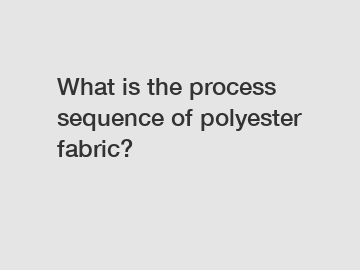Jan. 30, 2024
Gifts & Crafts
What is the process sequence of polyester fabric?
Polyester fabric is widely used in the textile industry for its durability, versatility, and wrinkle-resistance. Its manufacturing process involves several steps that transform raw materials into the final fabric. This article will explore the process sequence of polyester fabric, highlighting the key aspects and stages involved.
1. Raw Material Selection:

The process begins with the selection of raw materials. Polyester is a synthetic fiber made from petroleum-based products. The primary raw material used is a chemical compound called ethylene terephthalate (PET). High-quality PET chips are selected for the manufacturing process to ensure the desired fabric properties.
2. Polymerization:
Polymerization is the next stage, where the selected PET chips are melted and formed into a liquid polymer. This process occurs in a reactor vessel under high temperature and pressure, where catalysts are introduced to facilitate the polymerization reaction. The result is a thick, sticky substance known as polyester melt.
3. Extrusion:
The polyester melt is then extruded through a spinneret, which is essentially a metal plate with numerous tiny holes. As the polymer is forced through these holes, it takes the form of long, continuous filaments. These filaments are initially cooled and solidified by passing them through a cooling chamber, creating a web-like structure called a tow.
4. Drawing:
To improve the strength of the filaments, the tow is subjected to a process called drawing. In this stage, the filaments are passed through heated rollers that stretch and align them in a parallel arrangement. This stretching aligns the polymer molecules, enhancing the fabric's tensile strength and overall performance.
5. Annealing:
The drawn filaments are then heat-set through a process called annealing. This step stabilizes the molecular structure of the fabric and removes any residual stress from the drawing process. The filaments are passed through an oven at a controlled temperature, allowing them to relax and maintain their shape.
6. Spinning:
In the spinning process, the filaments undergo several transformations to turn them into usable yarns. First, multiple tow strands are combined to form a bigger bundle known as a spin pack. This bundle is then separated into individual filaments and twisted together to create a single yarn. The yarn is wound onto bobbins, ready to be used in fabric production.
7. Weaving or Knitting:
The polyester yarns are now ready for the fabric production stage. There are two primary methods for creating polyester fabric: weaving and knitting. Weaving involves intersecting yarns at right angles to form a stable fabric structure, while knitting creates loops of yarn that interlock to produce a stretchable textile. The choice between weaving and knitting depends on the intended use and characteristics desired for the final fabric.
8. Dyeing and Finishing:
Once the fabric is formed, it may undergo dyeing to add color. Polyester has excellent affinity for dyes, making it easy to achieve vibrant and long-lasting colors. After dyeing, the fabric goes through various finishing processes such as heat-setting, calendaring, or coating to enhance its properties. These processes can improve the fabric's strength, durability, and appearance.
In conclusion, the process sequence of polyester fabric involves selecting high-quality raw materials, polymerization, extrusion, drawing, annealing, spinning, weaving or knitting, and finally, dyeing and finishing. Each step contributes to the creation of a durable, versatile, and high-performance textile. From its origins as a liquid polymer, polyester goes through several stages of transformation before becoming the fabric we encounter in our everyday lives. Whether it's clothing, home furnishings, or technical textiles, polyester fabric has become an integral part of modern textile production.
Want more information on heating fabric, polyester steel, heat resistant material for sewing? Feel free to contact us.
If you are interested in sending in a Guest Blogger Submission,welcome to write for us!
All Comments ( 0 )